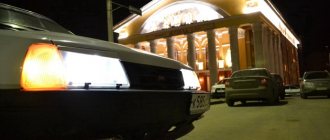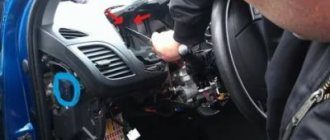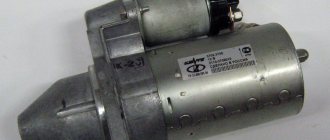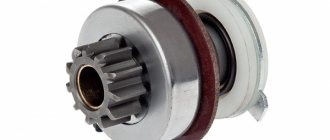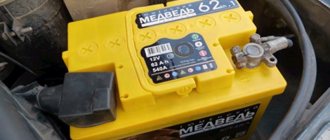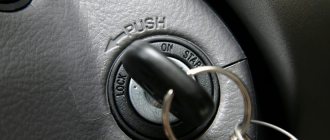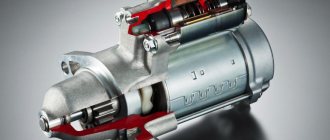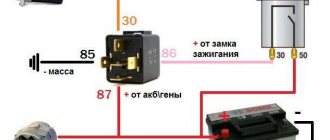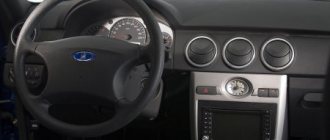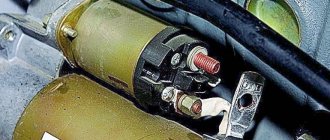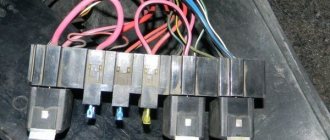09.10.2013
Starter-battery-ignition circuit diagram
Probably the most unpleasant thing that can happen is when you get into the car with thoughts of a good trip, turn the ignition key, and in response there is deep silence. And at this moment you remember all the swear words and pour them on your car. And it’s even worse when it’s -30 ºС outside and you’re already frozen to the bone. But let’s not talk about sad things, let’s just break down the main reasons for a non-working starter.
But! Before doing this, be sure to pay attention to other possible causes of the malfunction! Since in 90% of cases the problem of a non-working starter lies in completely different faulty elements.
Starter operating principle
The whole process proceeds cyclically, the time period of passage is 3-4 seconds.
The actions of one cycle can be divided into three stages:
- Connecting the gear to the flywheel;
- Direct start of the motor;
- Uncoupling the gear from the flywheel.
Immediately after turning the key in the ignition, electric current from the battery flows to the relay, setting the Bendix in motion. It engages the flywheel, which closes the circuit. As a result, voltage is supplied to the motor, increasing the rotor torque. Its transmission to the shaft of a car engine, through coupling with the flywheel, gradually increasing due to the ignition of several portions of the fuel mixture, leads to the final start of the engine. After this, the starter is turned off and will not be used for anything else.
Starters in cars with diesel and powerful engines are reinforced with gearboxes. This is an element with several gears that increases the voltage many times over.
The use of gearboxes provides a number of advantages:
- increased efficiency;
- consumption of weak electric current;
- works even at very low battery levels.
Recently, hybrid starters with generators have gained widespread popularity.
How to change a relay with your own hands?
To do this, we need to de-energize the on-board network - remove the terminals from the battery. Next, clean the surface of the starter from dust and dirt. Unscrew the nut from the relay and remove its contact. Unscrew the bolts securing the relay to the starter body. After this, remove the nuts from the end.
Next, you need to dismantle the old core and put a new one in its place. All elements are assembled in reverse order. It is important to check the operation of the new device immediately after repair. We install the starter in place, pump up the terminals and start the engine. The engine should start with half a turn (provided the battery is normally charged).
Why does the starter not respond to turning the ignition key?
After turning on the ignition, power from the battery is supplied to the on-board electrical systems and the computer (if equipped). If there is an immobilizer (standard or an installed security system), this occurs only after the tag is recognized. When the key is turned to the start position or the start button is pressed, the contacts of the solenoid relay are closed, resulting in power being supplied directly to the starter. At the same time, the starter overrunning clutch (Bendix) engages with the flywheel crown, setting it in motion and ensuring the engine starts. Often, switching is carried out through an additional starter control relay, which removes the load from the lock.
Ignition switching circuit
If a problem arises at any of the above stages, the car will not start: you turn the ignition key and the starter is silent.
As a rule, the reasons for this behavior lie in:
- ignition switch contact group;
- alarm and immobilizer;
- control relay;
- wiring from the control relay to the starter;
- starter solenoid relay.
More information about why the starter does not work with the ignition key can be found in the table.
If you experience any starting problems, first make sure that the battery has a sufficient charge level! When discharged, a residual current and voltage of 8–10 volts may be enough to turn on the ECU and the instrument panel, but not enough to power the starter. When power is applied to the starter, the solenoid relay may make a series of short clicks because the current is not sufficient to completely overcome the spring force of the solenoid.
What else do you need to know about relays?
Since the starter consumes quite a powerful current, the integrity of its elements should be checked every 100 thousand kilometers or every 3 years. During this time, slight fluctuations in voltage may occur in the mechanism, which can cause the relay to fail.
You can check its functionality by a characteristic click. It happens that when starting, the starter continues to work. In this case, you will hear a sharp squeal. This indicates that the retractor has failed. The mechanism cannot return to its reverse position.
The starter does not work from the ignition key: reasons
| Problem | Cause of malfunction |
| Starter motor faulty | The electric motor fails due to overheating, short circuits in the windings, wear of the brush assembly, and jamming of the gearbox. |
| The circuit from the ignition switch to the starter solenoid relay is faulty | Wiring break or short circuit. Often occurs after repairs, installation of additional equipment, or as a result of mechanical wear during long-term use. |
| Damage to the ignition switch (deformation of the cylinder) | Deformation due to overheating, which in turn occurs due to poor contact. Damage is also possible due to the mistaken use of an inappropriate key. |
| Electrical malfunction of the ignition switch contact group | The layer of oxides formed on the contacts prevents the flow of current. Also, the contacts may move away due to deformation of the rotary sleeve on which the mating parts are attached. |
| Start blocking by installed alarm | A voltage surge in the on-board network or loss of power (disconnection of a terminal or discharge), failure of a transistor or microrelay responsible for turning on the start line in the base unit of the security system. |
| Immobilizer malfunction/decoding | Voltage drops and sudden loss of power (battery discharged or terminal removed), software failure, failure of microelements. If the immobilizer does not recognize the mark, the starter does not turn after turning the ignition key, and the immobilizer symbol usually lights up or flashes on the indicator panel - an image of a car with a key or lock. |
| Failure of the solenoid relay | Burnout or short circuit of the winding as a result of overheating due to the flow of increased current or being under load for an extended period. The root of all problems is usually oxidation of the internal and external contacts of the solenoid relay. |
| The limit switch for the automatic transmission selector position, the brake pedal for an automatic transmission or the clutch for a manual transmission is faulty | Sensors fail due to mechanical wear, and their wires and terminals can oxidize or fray. Because of this, the ECU does not allow the starter to start. |
| Starter relay failure | If the starter control relay is stuck or shorted, it cannot supply power to the control terminal of the solenoid relay. |
| Poor “+” contact from the battery on the starter | The power contact terminal oxidizes under the influence of moisture and heat. The nut that holds it to the starter stud can come loose due to vibrations. |
| Poor ground contact at the battery terminal, car body or engine | Due to oxidation, the contact of the ground wire deteriorates; the same thing happens when its nut is unscrewed under the influence of vibration. In this case, the passing current may be enough to turn on the on-board network and the ECU, but not enough to drive the starter electric motor. |
Noise when rotating armature
In this case, check the condition of the drive shaft and armature bearing liners. Replace worn elements. The starter may have become loose or its cover at one end may be broken. Because of this, the mechanism works incorrectly. Inspect the flywheel itself. There should be no wear on its teeth. If present, the flywheel needs to be replaced. It happens that the gear does not disengage with it. In this case, the cause of the malfunction is in the clutch. It jams on the shaft splines. The VAZ-2115 starter relay can work normally. Clean the splines and treat them with oil. This helps eliminate jamming.
What to do if the starter does not turn the engine from the ignition switch
If when you turn the ignition key the car does not start, and nothing happens at all, in some cases you can correct the situation by supplying power to the starter, bypassing the lock. This solution is suitable for cases where the electric motor itself and the solenoid relay are in good working order. In this case, you need to proceed according to the following algorithm:
Control wire terminal
- Turn on neutral gear and ignition.
- Find two terminals on the starter: a thick power wire from the battery positive and a thin control wire from the control relay.
- Using a metal object (screwdriver, key, wire), close the power and control contacts.
- After the starter operates and the engine starts, immediately open the contacts.
An alternative to the same method is to supply power to the starter control terminal directly from the positive terminal of the battery. This can be done using any insulated wire, for example from a cigarette lighter wire kit.
The lack of response of the starter to direct power supply indicates its breakdown, failure of the electric motor or the solenoid relay. To diagnose the starter, you need to disassemble the starting unit, inspect the brush assembly, armature and stator windings. This is not easy to do in the field and without a multimeter, so you need to push the car and get to the garage or service station.
When the starter turns directly, but not from the key, then the starter itself is fully operational, and the problem lies in the electrical circuit from the key to the starter. To determine the location of the breakdown, you need to follow the instructions given below.
First of all, check the power contacts: battery terminals, ground terminals on the body and engine, two power contacts on the starter solenoid relay. Often the car does not start with the key precisely because of poor contact, so before more detailed diagnostics you need to make sure that power is supplied to the starter and that the ground wires are in reliable contact with the engine and body!
How to look for the reason if the car does not respond to the ignition key - instructions:
- The characteristic light click of the triggered starter relay when turning the key to the “start” position in most cases indicates the serviceability of the ignition switch and its contact group. Next, you need to look for the problem in the engine compartment.
- To check the solenoid relay, you need to connect a wire to its control terminal (a terminal with a thin wire) directly to the “+” terminal of the battery. A working relay should click and push the bendix towards the flywheel, and also start the starter rotating. The presence of a clicking sound without cranking the starter is a sign of poor contact of the power wire or a malfunction of the starter motor itself.
- You can check the serviceability of the motor by directly closing its retractor power contacts - they are made in the form of large diameter pins. If after this the starter spins, the retractor winding is faulty or it is jammed.
- For more detailed diagnostics, the solenoid relay must be removed from the starter and disassembled. First of all, look at the contact “nickels”, which can oxidize and burn. If there are traces of these processes, you need to clean the contacts, assemble the relay, return it to its place and check the operation of the starter. If everything is clean, you need to check the solenoid winding, for example, by ringing it with a tester for a short or open circuit.
- Check the starter control relay by locating it using your vehicle's wiring diagram. It can be located both in the relay and fuse switching block, and outside it. For example, on a VAZ 2108-2115 the starter relay is located under the hood, in the upper part of the engine shield on the driver's side. You can check whether current is supplied to the control wire using a tester or a control light: when you turn the key, a voltage of 12 volts should appear at the output of the relay (thin control wire to the starter) or the control light should light up. If there is no voltage, either the relay itself is faulty, or the problem is in the wiring closer to the lock.
- If the solenoid relay is working properly, the starter normally starts the internal combustion engine directly, the control relay also works and the engine can be started by supplying power to the relay - go into the interior and look at the wiring from the lock. First, you need to try to start the car without it, by closing the starting contacts together according to the existing electrical circuit. The easiest way to do this is on the classic VAZ family, where there are only 5 wires. On modern cars, the wires responsible for supplying power to the on-board network (ECU and other electronics) are first connected, then to the lighting and other systems, and then to the starter. If the method works, the problem is in the lock itself or its contact group. If startup does not occur, it is in the electronics (immobilizer, alarm) or in the sub-panel wiring.
Burnt contacts from the ignition switch are a common occurrence on VAZ cars - The faulty lock must be disassembled and its contact group inspected. If the contacts are oxidized, burnt or weakened, they must be cleaned and returned to their original position. If the mechanical parts of the lock are broken, it must be replaced.
- On a car with an automatic transmission, faulty limit sensors of the automatic transmission selector or brake pedal can block the starter. They need to be checked, for example, using a tester. The same applies to the clutch limit switch on some models with manual transmission.
Starting problems, if the ignition key does not turn the starter due to an immobilizer or alarm, are difficult to eliminate in the field. The same goes for wiring problems that require disassembling the panel. In such cases, it is better to contact a qualified auto electrician.
Fuel pump and related
The first malfunction is insufficient pressure in the fuel rail. During operation, the pump heats up and begins to pump poorly. Because of this, the car may stall and not start.
The pressure is checked by installing a pressure gauge. At idle in the system 2.5 atm, in power modes it should increase to 3. With a faulty pump, these indicators may differ between a cold and hot engine. Check in the mode in which problems arise.
One of the problems of the VAZ 2115 is the bypass valve, which, if faulty, begins to “let in” fuel on a heated engine. Bottom line: fuel pressure drops and takes time to build up. Symptoms are a long period of production or its complete absence.
Another reason for a drop in pressure in the system may be a clogged fuel filter or strainer in the tank. When heated, dirt expands and clogs the fuel flow.
Frequent malfunctions on popular cars
In most cases, the starter does not turn when the ignition key is turned due to oxidation and mechanical damage to the wiring. If there is poor contact with the “+” terminal of the battery, the control relay or ground, the starter does not receive enough current to crank the engine. Therefore, first of all, you need to look at the contacts in the engine compartment and check for voltage at the terminals with a tester. The most common malfunctions of specific car models, due to which the starter does not respond to the ignition key in the table.
| Why does the starter not work from the ignition key on popular car models? | |
| Auto | Weakness |
| VAZ 2110, 2111, 2112 | Wires of the central locking and ignition switch, which melt due to power surges. |
| VAZ 2108, 2109, 21099, 2113, 2114, 2115 (Lada Samara) | Oxidizing contacts of the control relay located in the engine compartment above the VUT, as well as the wiring extending from it. |
| VAZ 2101, 2102, 2103, 2104, 2105, 2106, 2107 (Classic) | The contact “nickels” of the solenoid relay often burn or oxidize. The contact group of the ignition switch fails. On later models, for example, 2107, problems with the control relay are similar to Samara (see above). |
| Niva | On old Nivas (before 21213), the ignition switch contacts burn and oxidize. On newer ones (after 21214), the starter control relay, located under the hood near the brake fluid reservoir, often fails. There is a drainage tube located nearby that drains water from under the glass, moisture from which gets onto the relay, which leads to oxidation of its contacts. |
| Lada Priora | Immobilizer problems due to which it does not see the key. |
| Lada Kalina, Lada Granta | Failure of the immobilizer, blocking the start, malfunctions in the contact group of the ignition switch and failure of the additional starter relay K3 in the fuse block. |
| UAZ | Malfunction of the 5-pin starter control relay and solenoid relay. |
| Gazelle | Poor contact of wires and failure of the starter relay. |
| Peugeot 307 | Solenoid relay fuse F8 blows, poor ground contact. |
| Kia Sid | The limit switch of the automatic transmission selector, which determines the P and N positions, is faulty. There may be poor contact at the starter terminals or at the point where the ground wire is attached to the body. |
DTOZh replacement procedure and timing
The procedure for replacing the DTOZh may differ depending on the car model. At the VAZ, to carry out the process, you need to prepare several tools, including the obligatory set of wrenches.
According to the classic scenario, the coolant will have to be drained, otherwise replacing the DTOZH cannot be called correct. Although there are several replacement options that do not involve draining.
As mentioned above, one of the DTOZH is located in the thermostat. It screws in from the side. The second is located a little lower, wrapped in the cylinder head.
A little about the timing of replacement of DTOZH. If we are talking about a regulator that goes to the pointer, then it must be replaced at the very moment when the temperature values go astray. This is easy to check: for example, when the engine is cold, the coolant needle tends to the red zone or simply wanders. This is an error and requires correction, i.e., replacement of the sensor.
In some cases, it also happens that it is not the regulator itself that is to blame, but the wiring or contact. You need to check everything, and only then decide whether to change it or not. Testing the wiring is also easy: the wires are disconnected from the DTOZH, the ignition is turned on and a short to ground is made. If the arrow jumps up, then everything is in order with the wiring.
The second DTOZH changes if the machine itself is not working properly. For example, the speed of a cold engine does not increase, but when it is hot it reaches a value of 1500 rpm. Fault number 2 can also be judged by the cooling fan, which turns on too early or does not do so at all.
Temperature controllers that have been removed are easiest to check. They must be immersed in boiled water heated to certain values, then connect an ohmmeter to measure the resistance coming from the DTOZH.
Impact of sensors
Most VAZ-2115 cars operate on the “January 5.1” controller. Crankshaft, temperature and throttle sensors are involved in starting the engine.
DPKV malfunctions usually appear regardless of temperature, but it is worth checking its resistance and comparing it with the data in the calibration table.
A more common malfunction is DT. Remove from position and place in a container with a cooler. We measure the resistance with a multimeter: it should be in the region of 1350 - 1880 Ohms. If you have a thermometer, you can check it using the table. If not, it doesn’t matter either, just heat it to an arbitrary temperature. As T increases, the resistance decreases. On a fully warmed up engine it is 87 - 109 Ohms. If the ohms do not change or drop to 0, change the DT.
The throttle assembly is completely disassembled and cleaned. One of the problems is dirt, which expands when heated and interferes with the normal operation of the injection. If the TPS malfunctions, the car not only does not start when hot, but also “does not drive” (sometimes stalls and does not start) after warming up.
The TPS is checked with an ohmmeter with the engine running. Place the multimeter on the input and output contacts, ask an assistant to press the gas. The readings should change and return to their original values at XX. If the resistance does not change when you press the pedal or the device shows infinity, the sensor needs to be replaced. At the same time we check the IAC. It usually causes the car to be unstable at idle or stall but start.
A malfunction of the mass air flow sensor on cars with January 5.1 is recognized by the fact that the car starts when hot and immediately stalls. The sensor comes into operation only after startup. But on a car with January 7.2, the mass air flow sensor is involved in the start - without it the car will not start.
Why is the VAZ 2114 8-valve injector difficult to start?
For some reason, it seems that many drivers of this model will be interested in the question of why the VAZ 2114 8-valve injector does not start well. Finding the cause of this phenomenon is not as easy as it might seem at first. This is due to certain difficulties in troubleshooting in this model, since injection systems differ from carburetor systems. The algorithm for identifying possible problems will be built differently, adapting to the design features of the machine.
Why is the VAZ 2114 8-valve injector difficult to start?
, we will try to consider in this work. In a short article it is impossible to consider absolutely all possible problems; there are some that can only be identified with the help of diagnostic equipment. But, nevertheless, we will try to analyze as many such situations as possible in order to help all VAZ 2114 owners decide what to do in such a situation.
Why might the engine be difficult to start?
You can look for the culprit in such a situation in several directions. Among them, the most important problems are:
- Malfunctions in the ignition of a VAZ 2114 car
- There is no pressure in the fuel rail of the 8-cl VAZ engine
- Air leak into the VAZ intake manifold
- Timing belt marks are misaligned
Engine diagnostics using spark plugs
Let's look at the first option, why the VAZ 2114 doesn't start well. To do this, unscrew the candles and look at their color. If there is black dry carbon on the candles, we can say that the engine has been running for a long time on a rich mixture, which covers the candles with black carbon.
Why does black carbon appear on the spark plugs of an injection car:
- Malfunction of the mass air flow sensor
- The first oxygen sensor has failed
- Fuel pressure regulator is faulty
- Malfunction of fuel injectors
White carbon deposits on the spark plugs of an injection car appear due to a lean mixture, the reasons for the appearance:
- Everything is the same as with black soot
- Malfunction of the fuel pump or clogged fuel filter (check the mesh and fine filter)
- Air leaks through the air flow sensor pipe, the place where the regulator is attached to the XX joints of the manifold.
Checking the spark plug spark
The lack of a spark on one 8-cl spark plug of a VAZ engine will not affect the engine starting, it will be noticeable when idling, tripping and jumping revs. But if the ignition module of the VAZ 2114 is faulty, then the spark disappears in two cylinders 1-4 or 2-3. To check the spark plug spark, take out the fuel pump fuse, unscrew one spark plug or take a spare one, remove the high-voltage wires one by one, put them on the spark plug, then put the whole thing on ground (in this case, the valve cover) and ask a friend to crank the engine with the starter, so we check each spark plug. If there is no spark on one spark plug, most likely there is a defect in the explosive wires; if there is a spark in two or all spark plugs, it is highly likely that the problem is in the ignition module or the wiring to it.
The timing marks on the VAZ are not set correctly
Another reason why the VAZ 2114 does not start may be a mismatch of the timing marks. The reason for the mismatch of the marks may be weak timing belt tension, cut teeth, or the crooked hands of a mechanic at a service station.
A discrepancy of more than two teeth will noticeably affect the operation of the engine of the fourteenth. With a slight deviation, the engine starts up a little worse, does not hold idle, and stalls when switching to neutral gear. If the deviation exceeds 4-5 teeth, the sound of the engine changes, air escaping under pressure through the valves that are not opened in time becomes audible, thrust noticeably disappears, and starting the engine is extremely problematic.
- To check, we need a “10” key; use it to unscrew the three bolts securing the timing case.
- Next, put the car in 5th gear and push it until the mark on the camshaft pulley and the rear cover match, you can also turn the pulley with the key to “17”
- We remove the protective plug from the clutch housing and see if the mark on the flywheel matches the mark; if not, then you need to loosen the tension roller and align the belt according to the marks.
Testing Bendix
If you are subscribers to my site, then you already know from the starter device that the bendix can only rotate in one direction. If you try to turn it the other way, it will jam. Thanks to this feature, you can check the bendix with the starter removed.
We remove it from the armature shaft and release it from the retractor relay plug. We hold the lower base with one hand and try to turn the gear in one direction. If it rotates freely in both directions, then it is faulty and needs to be replaced. Although there are craftsmen who restore its functionality.
If this test was successful and the bendix only spins in one direction, then we inspect it. Its gear must be intact, each of its teeth must not show signs of damage or deformation. If so, then the part needs to be replaced.
Video on how to check Bendix in a garage:
To Contents...
Candles
Unscrew the spark plug, place it against ground and crank the starter. If there is a spark, then there is probably a problem in the fuel system. We will tell you about it later.
It is necessary to do otherwise when the unscrewed spark plug works properly, but it turns out to be wet. Here you should check the timing belt. The latter sometimes jumps off, which disrupts the correct gas distribution and, accordingly, the VAZ engine does not want to start.
If you see that the spark plugs are filled with fuel, then perhaps this very circumstance is preventing you from starting the engine. Dry them with a burner or on a gas stove burner. When they turn out to be wet again during the next attempt, you will have to find out why this happened.
If there is no spark, the cause is sought further. It often lies in problems:
- crankshaft pulley or sensor that controls its position (DCPV);
- computer.
In most cases, the VAZ model 2109 injector does not want to start precisely because of the failure of the DPKV. Failure of other sensors does not prevent the engine from starting, it will simply not work correctly.
